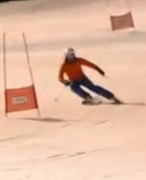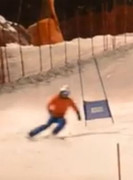Your inside foot is getting in front of the outside foot as well. Probably as a result of the upper body rotation. Think about tipping the lower legs to establish the edge, not pushing the outside ski to do so.
Mike
Mike
Luckily the first choice of antibiotics took care of the pneumonia, but took a while to get the "energy" back. So a bit of a compromised winter holiday
Entered my first GS-race ever just after. Went OK, no huge mistakes other the feeling of skiing too cautiously. Ended up ~16% behind the winner. Had a second race last week, ~17% behind the winner. Flat light and ruts in the first round made it difficult for me to commit. Felt better in second round when the lamps had more impact. But no improvement to last year according to the clock. I think the clock is a bit wrong and that I'm at least more consistent in not looking like a total clutzAnd the feedback from the coaches has been positive...
The last GS-video of the season. Somewhat same same as before.
My focus for the last week of training will be to be more brave in the top part of the steep section. Stop sliding sideways and start committing. I think I can ski a good bit faster if I just dare to do so...





Do you feel that lose of grip on the outside below the fall line? (If answer was "no" to that I'd ask you to ski it again and take note of it.) If "yes", then on to drills/adjustments for better fore/aft balance on that outside ski such as:
Anyway, enough of my barely informed commentary. Hope there's something in there that helps. It's interesting watching your racing develop.
- Javelin turns - hard to execute if not in the middle of the outside ski
- Improved inside foot placement to reduce that tip lead - see the JFB lesson on foot placement https://vimeo.com/ondemand/howtoskiepisodes/253005184 About $5. (An internal cue I find useful is to retain shin contact with the boot tongue on the inside ski.)
- With those in mind, a slightly later start to the transfer of weight to what will be the new outside ski. I understand you are running gates but I'm thinking that transfer shouldn't come at the expense of grip on what is still the outside ski. May be different if the fore/aft balance is improved.
To any instructors out there please MA my MA.


Thanks for your MA. Feel free to practice MAing on me anytime.
Don't remember that exact turn, but I think you are on to something. I tend to get very far forward on the outside ski toward the end of the turns and the inside ski gets to far forward. Too far back on the inside leg and too far forward on the outside. And it pops up in many kinds of situations. Tried telemark skiing for the first time in 10 years yesterday in some very slushy conditions. Worked fine in shallow turns not going far across the fall line, but got into trouble when trying to complete the turns more. When the heel is not fixed, being very forward on the outside leg make you eat snow head first. But at least the inside was pulled back....
What I see is that I loose counter and hip angulation early before the transition. I square up, loose hip angulation (like 0:13 or 0:23), transfer weight to the inside ski and then extend of the inside leg. Instead of holding/increasing the counter and hip angulation further and then flex the outside which then still would have weight.
Have tried to delay the weight transfer to force myself to stay angulated and countered longer in the end of the turns. Feel that it's working while freeskiing but obviously not able to take that into the gates yet. And I need video of myself outside of the gates to confirm that I'm doing what I think I'm doing...
Pretty good at javelin turns. Been doing a lot of those but feel I don't get transfer to real turns.Thanks for the tip on the JFB lesson. I will get that. I actually like his ramblings. Should probably get hip discipline 1 and 2 as well.
 Regardless, I think the fore/aft issue should be the 1st thing to work on.)
Regardless, I think the fore/aft issue should be the 1st thing to work on.)I know @razie and @Mike King mentioned rotation. I have a different take - from your turns in the vid (and the images above) it looks to me like you have enough separation and angulation through the fall line but then the outside ski loses grip and takes a path that's rather different to what the rest of your body is set up for. I suspect that fixing the balance issue by keeping that outside ski underneath you in the fore/aft plane will see improvement all round. (Then again, if I was a gambling person I'd probably put $10 on Razie and Mike being right...Regardless, I think the fore/aft issue should be the 1st thing to work on.)
@Smear, below are some stills from one of your transitions. I watched the videos in slo-mo. Your transitions look pretty consistent.
You start your turns by standing up and back, then dropping your whole body into the turn as a unit. If you want to ski faster in the gates, you need to know that standing tall between turns is slow. Staying low between turns is faster, because it allows you to get the skis up on edge quicker. Standing tall means you have to wait for the whole body to drop sufficiently to get the skis on edge, and that takes time.
Your skis do not grip the snow and bend early enough in the turn to take you around the gate cleanly. Your skidding scrubs speed. The speed-scrubbing skid you get as you pass the gate is due to dropping your whole body into the turn to get your edges. If you want to fix that, you need to tilt your lower legs to edge the skis without tilting your upper body, and you need to do that as you start the turn, in the transition. That will give you the angulation you need to improve grip with your outside ski, and minimize unwanted skidding.
Enact these two changes, and other things will come online naturally.
View attachment 70294
Fine, but you are missing the DIRT. Particularly the timing.Good points. And I'd agree with about everything although I'm doubtful that the OP is aft (as per comment 2nd pic above). If so it's a fleeting instant - that old outside foot is going from behind before transition to very in front just after.
Given that the CSIA Tech Ref points are an ordered guide to ski improvement and that balance is #1 I would have gone with getting the OP into the middle of the outside ski as the 1st priority. (Also, got pinged for something very similar in my Teach assess for L3 in March so perhaps I'm a little over-focused...)
Thinking laterally, there may be a way to address two issues - need to be in the middle of the ski and need angulation in the ankles/knees above the fall line - at once...
45 degree shins:
Stand stationary, body square to the skis. 90 degrees is perpendicular to the skis left or right. Draw a line in the snow at 45 degrees to the skis. Now, without twisting the skis, turn legs in hip sockets and roll skis on edge with the ankles so that both knees go towards that 45 degree line. Should feel the sides of the boots rather than the front. Practice in rail road track turns and then take that same movement and feel into the skiing.
The aim is to convert the forward pushing into the boot to a more of a lateral movement of the lower body. Being less forward at the top means staying in the middle of the ski through the turn. And with angles from the lower legs the skis will be on edge earlier (giving platform angle!) without early inclination of the upper body. Then, as the forces build up in the turn, there will be plenty of room to incline and get good performance out of the skis.
This doesn't do much to address the issue with extending the new outside leg whilst not lifting the CoM however my suggestion would be to prioritise it as:
1. Middle of the outside ski
2. Early angles with the lower body
3. Lateral outside leg extension
Look forward to some feedback from @Smear
Fine, but you are missing the DIRT. Particularly the timing.
If he starts to flex to release before edge change and extends the outside leg after edge change, he will move aft on the ski from apex to edge change, and move forward from edge change to the apex. That should put him in a more centered position on the ski, as long as he gets away from crushing the front of the boot.
Mike
....
@Smear, apologies if this is starting to feel like a dissection. So far this has been a good learning exercise for me. Even on snow seldom get a chance to ask working instructors the details of their thought processes. It would be very neat to do this exercise in real time and see the effect on a student's skiing.
When you do javelins, where on your outside foot do you feel you are mostly balanced - ball of the toe or heel or along the whole foot? And same question for doing normal turns?
Not a bad idea to do some drills in gates now, like dragging your outside pole.
cheers